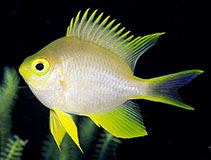| Family: |
Pomacentridae (Damselfishes), subfamily: Pomacentrinae |
| Max. size: |
13 cm TL (male/unsexed) |
| Environment: |
reef-associated; marine; depth range 0 - 60 m, non-migratory |
| Distribution: |
Western Pacific: Andaman Sea (Ref. 7247) and Christmas Island in the eastern Indian Ocean to Fiji, north to the Ryukyu Islands, south to Rowly Shoals (eastern Indian Ocean)and New Caledonia. Recently recorded from Tonga (Ref. 53797). |
| Diagnosis: |
Dorsal spines (total): 13-13; Dorsal soft rays (total): 12-16; Anal spines: 2-2; Anal soft rays: 14-15. Description: Head and body golden yellow, spots blue small on the face; fins yellow. Body depth 1.5-1.7 in SL. Suborbital scaleless (Ref. 90102). |
| Biology: |
Adults occur in steep outer reef, occasionally in deep lagoons and along channel walls, usually in current prone habitats and where there are abundant gorgonian and long sea-whip corals on which they lay and guard eggs. Juveniles in small groups often found among large sea fans or black corals. Feed on zooplankton (Ref. 7247). Oviparous, distinct pairing during breeding (Ref. 205). Eggs are demersal and adhere to the substrate (Ref. 205). Eggs laid usually on gorgonian dead branches (Ref. 90102). Males guard and aerate the eggs (Ref. 205). |
| IUCN Red List Status: |
Least Concern (LC); Date assessed: 15 November 2010 Ref. (130435)
|
| Threat to humans: |
harmless |
Source and more info: www.fishbase.org. For personal, classroom, and other internal use only. Not for publication.

